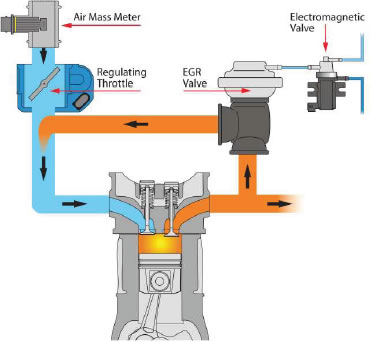In internal combustion engines, exhaust gas recirculation (EGR) is a nitrogen oxide (NOx) emissions reduction technique used in petrol/gasoline and diesel engines. EGR works by recirculating a portion of an engine's exhaust gas back to the engine cylinders. This dilutes the O2 in the incoming air stream and provides gases inert to combustion to act as absorbents of combustion heat to reduce peak in-cylinder temperatures. NOx is produced in a narrow band of high cylinder temperatures and pressures. https://en.wikipedia.org/wiki/Exhaust_gas_recirculation
So why do you need to clean it?
Unless you have DCT code with specific EGR problem (stuck open, stuck closed, insufficient lift, etc) it can also be a cause for car shaking and strange power loss at around 1200-1300 RPM.
I didn't have any issues with my car it's just DIY maintenance and reference point. All you need is Carb cleaner, rags, tool set, 2 wires (for extra cleaning) and free time. All procedure can take 15-30 minutes.
It's typical look at Honda below (I forgot to take pictures).
Actually we did 2 EGRs today: mine and my friend's. I'll start with mine.
So, that's what I got for 35Kkm of using my Civic.
I call this nothing to clean :-)
Really, there is almost nothing to clean. I saw EGR from 8 years old car - that total black thing. Here we can see little "beard".
Conclusions from pictures:
1. If engine is you can clean/check it first time at 45 or 60 kkm. If engine drink oil, you will see it here too.
2. Engine is healthy. Meets with tail pipe test I did before.
Gasket was left on engine. Gasket is fine, no damage. Pull EGR out gently and better on cold engine.
Btw, torq spec for unscrewing was 43.1 Nm. Honda's torq spec for nuts is 22 Nm.
On engine side it was also clean, I didn't spray there.
Now, to fully clean the valve, you need to open it. That's easy to do with 2 small crocodile jumpers because this thing requires 12V to full open.
This is a connector housing. I saw different connector on internet in 2 rows but that's almost the same.
Take look here - 5 wires. It may be hard to see but 1st and 5th (from left) are thicker - these are feed wires. 3 in the middle is feedback for ECU how valve behaves (inside is sort of slider on potentiometer). ECU applies 0 to 12V to feed wires to control valve lift.
It's not important which is positive and where is negative in DC circuit but I took test light, attached it to battery positive and touched 1st black wire - and we saw light, so black is negative and blue with red tracer is positive.
This is what happens when you connect it to battery.
That's it. Put it back, screw nuts with about the same torq spec. No adaptation needed.
Now, same EGR on same Honda Civic but with 45kkm driven (manual transmission - not so important).
Valve came out without a gasket and gasket had light damage
It wasn't necessary to replace the gasket but as I had 2 spare we just changed it.
Cost me about $6, part number is 18715-PB2-000.
Engine look under a gasket.
Also, useful video about what inside EGR (https://www.youtube.com/watch?v=rHdcH26j9NY)
Next post will be throttle body cleaning. I did it long time before and it's very interesting story again including Honda "professionals".
35,300 km | 2Y 4M




















No comments:
Post a Comment